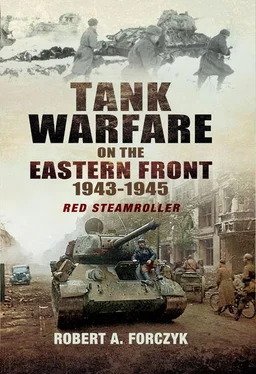Before us was the Russian field position. We pushed the Russians out and took some of the enemy trenches. I moved forward. We’re hit by an anti-tank round. Then we were hit again. Out tank caught fire. Nothing to do but get out! My gunner and loader were able to get out quickly. I received a couple of small burns. I heard my other two comrades, the driver and the radioman, who did not get out in time, as they burned to death in the blazing Panzer. The Pak shot must have penetrated the frontal plate. We then worked our way to the rear. {147}
Before Das Reich could renew its effort to clear Stepanovka, it was struck by a large-scale counter-attack from the south at 0330 hours. Waves of Soviet infantrymen, supported by 70 tanks, converged on the town and the attack stunned the Germans by its ruthlessness. Das Reich ’s Panzergrenadiers managed to hold onto one corner of the town by their fingernails but the panzers were forced to retreat and the Soviets mounted 14 separate attacks against the town during the day. SS-Panzergrenadier-Regiment Der Führer held its ground, but suffered over 200 casualties. However, Soviet casualties were much heavier and Das Reich took 1,400 prisoners. In the afternoon, heavy rain put a damper on the fighting for a while, but it was obvious that II.SS-Panzerkorps had failed to gain any ground. By the end of the day, Hausser’s II.SS-Panzerkorps only had a total of 38 tanks (2 Tigers, 15 Pz III and 21 Pz IV) and 34 assault guns still operational. Once again, Nehring’s XXIV Panzerkorps had a better day than the Waffen-SS, beginning with the elimination of the pocket created the day before. Elements of four Soviet rifle divisions were wrecked in this mini- Kessel and 52 anti-tank guns were captured. During the fighting around the pocket, the 23.Panzer-Division managed to destroy an SU-152 self-propelled gun, allowing the first close inspection of this new enemy vehicle. However, 23.Panzer-Division was reduced in strength to just 15 tanks and one assault gun, while 16.Panzergrenadier-Division had 12 tanks and 22 assault guns. {148}
Von Manstein was incensed when he learned about the scale of tank losses in Operation Roland and he flew to Hollidt’s headquarters in Stalino. In just two days, Hollidt’s forces had lost 105 tanks, including 24 Totalausfalle , and gained very little ground. Von Manstein wanted to suspend the operation before II.SS-Panzerkorps was wrecked, but Hausser argued that he could accomplish his mission. In reality, the Waffen-SS was being built up by Nazi propaganda as an elite assault force and failure at the Mius River would have serious repercussions in the struggle for resources in the Third Reich. Himmler was in the process of establishing more Waffen-SS mechanized divisions and he could not afford for Hausser’s II.SS-Panzerkorps to fail to accomplish its mission twice in one month. Hausser was probably not high in von Manstein’s regard, given that he had openly disobeyed his orders twice before, but he agreed to let the operation continue for a few more days. Waffen-SS tactics on the first two days had been crude and costly and von Manstein urged a more methodical approach.
Hollidt assembled all available artillery and put it at Hausser’s disposal for an all-out attack on 1 August. By this time, the Germans knew where most of the Soviet artillery and anti-tank guns were located and thus the artillery preparation that started before dawn was far more effective. Prior to the ground assault, Nebelwerfer batteries created a thick smoke screen to conceal the advancing German infantry and tanks, thereby reducing the effectiveness of Soviet defensive fire. After much heavy fighting, Das Reich finally captured Stepanovka and then its panzers swept eastward, overrunning some of the anti-tank units blocking Totenkopf ’s path. By 1600 hours, the centre of the Soviet defensive line was near collapse. However, Tolbukhin’s troops made one last desperate counter-attack with several thousand infantrymen that nearly overwhelmed Hausser’s exhausted troops before they could consolidate on the objective. SS-Unterscharführer Rolf Stettner, in another tank, once again fought for control of Hill 213.9:
…With all our power we sped toward the Pakfront… I ran over a Pak. Under our wheels and treads the metal crunched. We halted behind the enemy gun and raked every movement with the turret [coaxial] machine gun… I saw three T-34s moving to our left. ‘Turret! 11:00 o’clock, range 400 meters, Panzergranate 39, tank!’ the gunner calls out. ‘Ready! Fire!’ The shell hit the first T-34 under the turret. The turret hatch flew open but no one jumped out as white smoke rolled out of the hatch. The next round was loaded and ready. The second T-34 literally exploded into pieces. The next shell hit and penetrated the motor of the third T-34. It also caught fire and a black column of smoke rose high into the air. {149}
In the south, the XXIV Panzerkorps achieved a major breakthrough and advanced toward the Mius. By evening, the Soviet defence crumbled and the remaining units began retreating across the Mius. On 2 August, Hollidt’s forces advanced to the river and crushed the last resistance in the bridgehead. Tolbukhin’s forces had suffered a major defeat, leaving behind 17,895 prisoners, but the remnants of 2 GMC and 4 GMC escaped across the river. Although a tactical success, the Mius River fighting was extremely costly for the Germans. Overall, AOK 6 suffered 21,369 casualties in the 17-day battle. Hausser’s II.SS-Panzerkorps was virtually burnt-out: Totenkopf suffered 1,458 casualties in its four-day attack and was reduced to just 23 operational tanks, while Das Reich suffered nearly 1,000 casualties and was left with 22 tanks. {150} While many damaged tanks would be repaired in time, losses in Panzergrenadiers and pioniers were particularly crippling and not easy to replace. The 3. and 23.Panzer-Divisionen were also reduced to a very depleted condition and 16.Panzergrenadier-Division was wrecked (3,957 casualties between 17–31 July) by the Battle for the Mius Bridgehead. Tolbukhin’s short-lived Mius bridgehead succeeded in causing von Manstein to disperse his armour after Zitadelle and then crippling his strongest formation, II.SS-Panzerkorps.
Operation Rumyantsev , 3–23 August 1943
After the failure of Zitadelle , von Manstein believed that the Soviets would eventually mount a major offensive to retake Kharkov, as this had consistently been an objective for them. Once Hoth’s and Kempf’s forces withdrew to their original start lines, this possibility became increasingly likely. However, von Manstein also believed that it would take Vatutin’s Voronezh Front at least a month or more to recover its strength after the Battle of Kursk. In particular, he over-estimated the amount of damage that Vatutin’s two tank armies had suffered and he underestimated the ability of Soviet field workshops to repair damaged tanks. In fact, it took Vatutin just two weeks to refit his armies and prepare his own offensive, which the Stavka had designated Operation Rumyantsev . [35]
During the two weeks following the end of Zitadelle , the balance of forces had sharply changed in the Kharkov-Belgorod sector as von Manstein sent II.SS-Panzerkorps to the Mius and von Knobelsdorff’s XXXXVIII Panzerkorps lost 3.Panzer-Division to Operation Roland as well. Soviet deception efforts ( Maskirovka ) by 38th Army near Sumy convinced von Manstein that Vatutin might try an attack against the boundary of Hoth’s PzAOK 4 and 2.Armee, so he shifted the 7.Panzer-Division and part of 11.Panzer-Division west to that sector. {151} In addition, Großdeutschland was sent to reinforce Model’s AOK 9 and Panzer-Regiment 39 was disbanded. By the end of July, Hoth’s PzAOK 4 was a shadow of its former self, with only Generalleutnant Gustav Schmidt’s 19.Panzer-Division and Major Karl von Siver’s Panzer-Abteilung 52 in tactical reserve near Tomarovka. Schmidt’s 19.Panzer-Division had 49 tanks and assault guns, including about 20 Pz IVs, while von Sivers only had 27 operational Panthers. Armee-Abteilung-Kempf’s sole armoured reserve was Oberst Wilhelm Crisolli’s 6.Panzer-Division, which had 28 tanks (mostly Pz III). Most of Hauptmann Clemens-Heinrich Graf von Kagenek’s s.Pz.Abt. 503 was pulled back off the line to rest in Kharkov, but the six operational Tigers were left with XI Armeekorps to defend Belgorod; the handful of Tigers remaining in this critical sector demonstrates the weakness of Zetterling’s Totalausfalle -based statistics to explain the results of Kursk. Despite the fact that the s.Pz.Abt. 503 had only lost seven of its 45 Tigers as Totalausfalle during July, it still had 32 tanks awaiting repairs when the Soviet counter-offensive began. Similarly, 106 Panthers were also still under repair. Not only was the Wehrmacht not receiving enough new Panzers, but it was having greater difficulty repairing damaged ones. Altogether, Hoth and Kempf could barely scrape together 200 tanks and assault guns in the Kharkov-Belgorod sector at the beginning of August 1943.
Читать дальше








![John Stieber - Against the Odds - Survival on the Russian Front 1944-1945 [2nd Edition]](/books/405234/john-stieber-against-the-odds-survival-on-the-russian-front-1944-1945-2nd-edition-thumb.webp)



